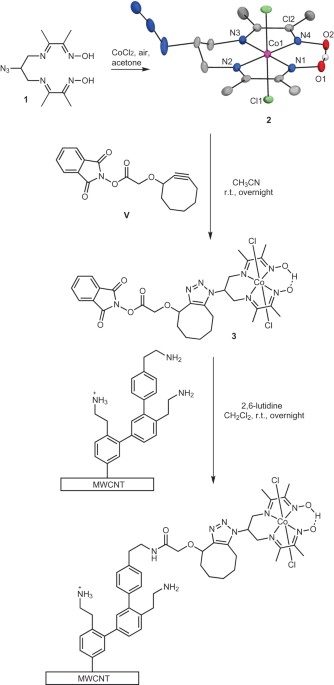
Molecular engineering of a cobalt-based electrocatalytic nanomaterial for H2 evolution under fully aqueous conditions
- Select a language for the TTS:
- UK English Female
- UK English Male
- US English Female
- US English Male
- Australian Female
- Australian Male
- Language selected: (auto detect) - EN
Play all audios:

The viability of a hydrogen economy depends on the design of efficient catalytic systems based on earth-abundant elements. Innovative breakthroughs for hydrogen evolution based on molecular
tetraimine cobalt compounds have appeared in the past decade. Here we show that such a diimine–dioxime cobalt catalyst can be grafted to the surface of a carbon nanotube electrode. The
resulting electrocatalytic cathode material mediates H2 generation (55,000 turnovers in seven hours) from fully aqueous solutions at low-to-medium overpotentials. This material is remarkably
stable, which allows extensive cycling with preservation of the grafted molecular complex, as shown by electrochemical studies, X-ray photoelectron spectroscopy and scanning electron
microscopy. This clearly indicates that grafting provides an increased stability to these cobalt catalysts, and suggests the possible application of these materials in the development of
technological devices.
This work was supported by the French National Research Agency (ANR) through Grant 07-BLAN-0298-01, Labex program (ARCANE, 11-LABX-003) and Carnot funding (Institut Leti). The authors thank
the New Technologies for Energy Program of CEA (project pH2oton) and P. Jegou for XPS measurements.
Laboratoire de Chimie et Biologie des Métaux (CEA/Université Grenoble 1/CNRS), 17 rue des Martyrs, Grenoble Cedex 9, F-38054, France
Eugen S. Andreiadis, Pierre-André Jacques, Phong D. Tran, Murielle Chavarot-Kerlidou, Marc Fontecave & Vincent Artero
Department of Technology for Biology and Health, CEA LETI-MINATEC, 17 rue des Martyrs, Grenoble Cedex 9, F-38054, France
CEA, IRAMIS, SPCSI, Chemistry of Surfaces and Interfaces Group, Gif sur Yvette Cedex, F-91191, France
CEA, INAC, LCIB (UMR-E 3 CEA, UJF-Grenoble 1), 17 rue des Martyrs, Grenoble Cedex 9, F-38054, France
Collège de France, 11 place Marcelin-Berthelot, Paris Cedex 5, F-75231, France
V.A., B.J., S.P. and M.F. designed the research, E.S.A., P-A.J., P.D.T., A.L., M.C-K., M.M. and V.A. performed the research, J.P. performed the X-ray crystallographic studies and V.A. and
E.S.A. co-wrote the paper.
Patent applications (EP-08 290 988.8 and E.N.10 53019) have been filed for the preparation of azide-appended diimine–dioxime complexes such as 2 and their grafting onto electrode materials.
Anyone you share the following link with will be able to read this content:
